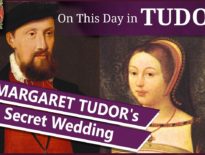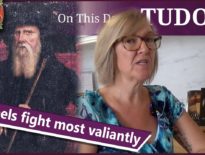On this day in Tudor history, 5th August 1600, John Ruthven, 3rd Earl of Gowrie, and his brother, Alexander Ruthven, Master of Ruthven, were killed in mysterious circumstances at Gowrie House near Perth in Scotland.
Why am I talking about a Scottish event? Well, because the brothers were killed as they allegedly tried to kidnap, King James VI of Scotland, who, in 1603, inherited the English throne from Queen Elizabeth I.
But what happened? Did these men really try to kidnap the king or was there more to the story?
Find out in today's talk.
On this day in Tudor history, 5th August 1549, during the reign of King Edward VI, son of King Henry VIII, the Battle of Clyst St Mary took place near Exeter, in Devon. It was part of the Prayer Book Rebellion, a rebellion against the religious measures of King Edward's government. Find out what what provoked this rebellion and what happened when the Crown's forces got to Clyst St Mary in last year’s video:
Also on this day in history:
- 1503 – Death of Sir Reynold (Reginald) Bray, administrator in the reign of Henry VII. He served the King as Chancellor of the duchy of Lancaster, Treasurer of England and Treasurer for war. Some say that he was an architect and designed Henry VII's Chapel in Westminster Abbey, St George's Chapel in Windsor Castle, where he is buried, and Great Malvern Priory. He definitely funded their building.
- 1532 – Death of Sir Nicholas Harvey, diplomat, at Ampthill, Bedfordshire. He was buried in Ampthill Church where his memorial brass can still be seen.
- 1601 – Burial of Henry Norris, 1st Baron Norris of Rycote, courtier, diplomat and son of Sir Henry Norris, one of the men executed for alleged adultery with Queen Anne Boleyn. Norris was buried at the chapel at Rycote in Oxfordshire.
Transcript:
On this day in Tudor history, 5th August 1600, John Ruthven, 3rd Earl of Gowrie, and his brother, Alexander Ruthven, Master of Ruthven, were killed in mysterious circumstances at Gowrie House near Perth in Scotland.
Why am I talking about a Scottish event? Well, because the brothers were killed as they allegedly tried to kidnap, King James VI of Scotland, who, in 1603, inherited the English throne from Queen Elizabeth I.
But who were these men and why did they try to kidnap the Scottish king? Let me tell you…
• John and his younger brother, Alex, were the sons of William Ruthven, first earl of Gowrie (c. 1543–1584), and his wife, Dorothea Stewart.
• In 1588, John became Earl of Ruthven, following the death of his older brother James. The brothers had been allowed to inherit the earldom even though their father had been executed as a traitor in 1584.
• John and Alexander were both educated at Perth Grammar School and the University of Edinburgh. Contemporaries described John as “of great expectatioun, and much respected by the professors” and Alexander as “a learned, sweet and hurtless young gentleman”.
• In 1592, John was elected as Provost of Perth and in 1593 his mother and sister helped smuggle Francis Stewart, 5th Earl of Bothwell, into Holyrood Palace. Bothwell then forced himself, brandishing a sword, into King James’s bedchamber. He wasn’t there to harm the king, though, he was there to protest his loyalty following his attainture for treason.
• In October 1593, John signed a letter with his brother-in-law, the Earl of Atholl, and others, to Queen Elizabeth I, in which they offered to serve her and support her policies in Scotland.
• In the summer of 1594, John travelled to Padua to study at the university there, then he moved on to Rome and Venice, before travelling to Geneva in 1599. There, he stayed with reformer Theodore Beza for nearly three months, before travelling on to Paris, where he met Queen Elizabeth I’s ambassador, Henry Neville, who subsequently reported to the queen that John was “exceedingly well affected to the cause of religion, devoted to Elizabeth's service, and a nobleman of whom, for his good judgment, zeal, and ability, exceeding good use could be made on his return.”
• John arrived in London in April 1600, where he received a warm welcome from the queen, and then he travelled to Edinburgh and then on to Perth.
• In June 1600, despite the fact that the king had approved John’s request for protection from his debts for one year, John was outspoken in his opposition of King James VI’s taxation plan to fund his army, stating that it was dishonourable of the king to ask for more than Scotland could give him. The king was furious.
• According to King James’s account of events, the king was setting off for a day of hunting from Falkland Palace’s stables at 7am on 5th August 1600, when he was approached by Alexander who informed him that he had important information for the king’s ears only. Alexander claimed that he’d met a mysterious man carrying a large pot of gold coins and that he’d locked up the man and the gold in his brother John’s house, Gowrie House. Alexander wanted the king to question the man. James was suspicious, but knew that if the man was a Jesuit priest and he was carrying foreign coins, that he could confiscate the money so it was worth checking out.
Another version is that John claimed that he’d found treasure in his home and wanted to use it to help the king.
Still another version is that James surprised John with a surprise visit, John being slightly forewarned by his brother riding ahead.
Whatever the cause of the visit, the king dined at Gowrie House and after dinner allegedly left the dining room with Alexander. A bit later the king was seen and heard crying “I am murdered! Treason! My Lord Mar, help! Help!” The king’s men went to help, killing Alexander on the way. John was also killed in the subsequent commotion.
Did John and Alexander concoct this plot to kidnap the king, a man who’d been responsible for the death of their father? Or was James’s account a cover for assassinating two men who were getting in the way of his policies? Or was it just a spontaneous brawl?
It’s impossible to know as the two men accused of plotting against the king were conveniently killed.
• John and Alexander were posthumously found guilty of treason on 15th November 1600 and their bodies hanged, drawn and quartered in Edinburgh, their head being displayed at Edinburgh’s Tolbooth and their limbs around Perth.
• 5th August was designated as a day of celebration for the king escaping this conspiracy unharmed.



I think James took the opportunity to get the two brothers killed because the crown was at odds with the family. He owed them money, their father had killed David Rizzio and plotted to get rid of Darnley. The family were allegedly involved in an earlier plot and James felt he was not safe. Although his men were close by, he was apparently locked in a room with an armed servant after John had threatened him. He gave the cry of treason, thus justifying an armed attack in which both John and Alexander were killed. Its an open question still, but my money is on James staging the entire thing and an attempt to hold him hostage got out of hand. James was up to his eyes in debt to the nobility and had escaped several kidnappings and assassination attempts on him or his Regent or guardian. He definitely wasn’t going to let this one go. I don’t believe James was above murder and an attempt on his person, even a threat was treason and homicide justified of the assassins on that basis. Its a wonder he didn’t an an allegation of witchcraft.
There is more to this story. James wife had an affair with one of the Ruthvens. Also the Ruthvens had an equal right to the crown.
The more I read about this strange event over the last few days, the more it looks like something the King set up or at least took advantage off. The tale of lost treasure is most likely nonsense, but James had
a.. killed their father
b.. been kidnapped by the family before
c.. borrowed thousands of pounds from them
Andrew Laing certainly thinks that Alexander made threats but didn’t intend to physically harm the King. James made a fuss, opened a window and called for help from men he had dismissed but knew were below. John came to his brother’s aid, but was also killed in the resulting fight. James faced a cross examination by the Kirk during which time this official version emerged. Members of the Kirk accepted the official version as a way of supporting James, but a number of them asked questions which suggested they didn’t actually believe him. The Medieval Kirk would have insisted the King did penance for this incident even if it was justifiable homicide. The more you read around this double murder, the more you realise it was linked to the attempt to kidnap James in 1589 which saw him held hostage by the Government for eighteen months and held for several weeks by the Ruthven family at their castle. James might well plead he was too young to have been directly responsible for the execution of John and Alexander’s father, William, but that’s not how these two hotheads saw things. I believe this was another attempt, not to kill James but to force him to admit responsibility. I believe they wanted him to sign papers which cleared their father and to force him to do so. I believe Queen Elizabeth I had been involved in the original coup which was against corruption and financial mismanagement because she supported the Ruthven cause and regime, brief though it was. Henry Viii and his daughter, Elizabeth were a pair of nosy pokes who regularly interfered in Scottish politics and caused aggression between the two countries. Neither could resist anything which might benefit England and Elizabeth expressed disappointment when the Ruthven administration fell.
James, canny as he was, knew something was afoot that afternoon and yet he went to Gowrie without his usual retinue. James was paranoid and yet allowed himself to be lurred into a locked room with two armed men! You can’t tell me he didn’t smell a rat and take precautions. He was at the home of the sons of known traitors, he was there with few people to protect him, they didn’t go and look at this alleged treasure at once and he was well fed by his hosts. A man of James’s intelligence and paranoia doesn’t act like that if he is sober. No James had ever intention of closing a trap if one was opened and he seemed to be in full control of the situation, either to set up the brothers for treason or to kill them if the opportunity arose. James saw an opportunity, he manipulated the events that followed his own entrapment to favour himself and luckily for him Alexander and John Ruthven were killed. No Scottish King can put himself above the law, that’s why he was questioned, but they could use it to favour themselves. His version of events was consistent enough with his witnesses and it has been accepted as the most likely scenario. But was it? Unfortunately after 500 years, unless someone wrote down something different and it is verifiable, we will never know for certain. Here’s to canny King James, who may actually have created the perfect crime.